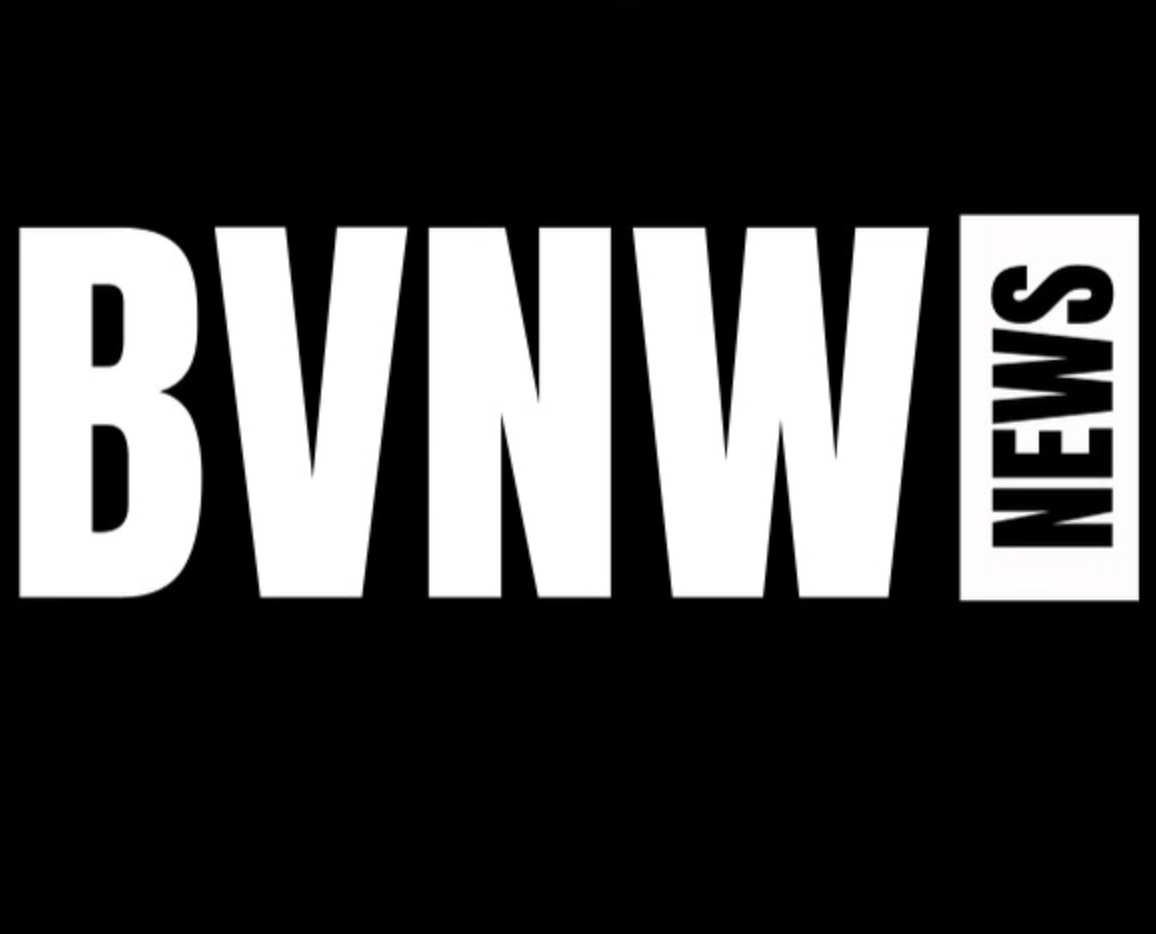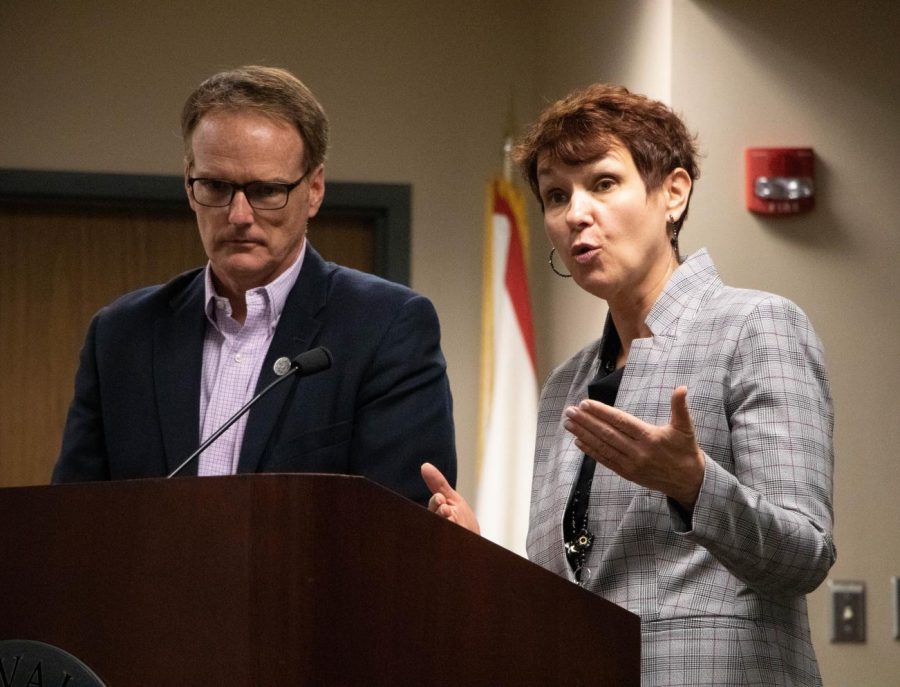Blue Valley District proposes 2020 bond issue
Blue Valley School District proposes bond issue for January vote.
Deputy Superintendent Mike Slagle (left) looks on as incoming Superintendent Tonya Merrigan (right) answers questiosn about the bond issue.
Courtesy of the Blue Valley School District
October 15, 2019
Asking for close to $187 million, the Blue Valley School District (BVSD) plans to reinvest in and reinforce current District owned property with a new bond issue set to go to vote in 2020. Needing only a majority vote to pass, BVSD highlights the bond’s no tax rate increase as its main benefit for constituents, alongside the innovation of school property. Residents within the District’s boundaries will be able to vote from Jan. 8 to 28, with the vote consisting of a mail-in ballot.
A bond fund is one of three funds the Blue Valley School District can obtain money from. The Blue Valley District is unable to double dip between the three funds. With the other two funds offering the Blue Valley District the ability to pay salaries and perform maintenance, the BVSD uses the bond fund to finance long term projects and improvements. This can consist of improving current school equipment, upgrading safety or constructing new things and a bond issue is the only way to raise money for the fund.
In order to acquire the asking amount, a resident’s tax rate, if living with in BVSD boundaries, won’t be increased, but their taxes will most likely go up. According to Deputy Superintendent Mike Slagle, if a homeowner’s home appreciates in value, then their taxes will go up, financing the fund. In addition to this, homes with in the Blue Valley District boundaries generally appreciate on average, according to the Blue Valley Schools Bond 2020 website.
When spending money from the bond, the Blue Valley District will have to reimburse taxpayers for their contributions, Slagle said. The worst-case scenario for the estimated amount of interest the BVSD would have to pay back on top of the initial amount is set at $84 million dollars. Slagle said despite the large bond referendum, he is confident the Blue Valley District will not have to pay that amount back because of two main factors.
“That won’t happen because we have such a great bond rating [and it] will be much lower than what we had to publish,” Slagle said. “We’re [also] going to be paying chunks of this off early. So therefore, it will be nowhere close to 84 million. I just can’t say what it’s going to be at this point”
Previously proposing bond issues in seven year increments, Slagle said the 2020 bond is a three year bond. By shortening the time allotted in between the proposed projects, Slagle said this is another way the Blue Valley School District can drive down the interest cost.
In spite of this expressed confidence, Slagle said the Blue Valley School District has yet to fully pay back the debt on their 2005 and 2012 bond issues.
If the bond is not passed, incoming superintendent Tonya Merrigan said the Blue Valley District would have to make due with the current funds in the bond fund in order to accomplish proposed projects in the 2020 bond.
The three main goals of the proposed bond issue are to reinvest, reinforce and reimagine the Blue Valley School District.
Heading the reinvestment section of the proposal is the addition of another gym in each of the District’s three oldest high schools, including BVNW. Although not knowing where it will be situated on the school grounds just yet, Slagle said the addition will be a top-feeding auxiliary gym, set to pair with the two original gyms already in place.
In conjunction with the addition of gyms in the three oldest high schools, the reinvestment sector also includes upgrading aging facilities, theater modifications in all high schools and middle schools and continued integration of technologies. Merrigan said the theater modifications were of critical importance to the District in hopes of increasing the safety of the environment.
Coupled with the plans to reinvest in current District property, is for the District to reinforce current school conditions. These additions include door locks capable of being locked from the inside, open door sensors and updated safety systems. With door locks, capable of being locked from the inside, not being offered in BV schools until recently, Merrigan said they have already seen the benefits from the newly implemented locks.
“We have put in some of those door locks and some of our newer schools, Wolf Springs Elementary for example, has those in them,” Merrigan said. “And so, we’ve been able to firsthand see the benefit of that.”
Adding to Merrigan’s comments, Slagle said the proposed security changes are being made in order to reassure students of their safety.
“If I could wave my magic wand, there would not be a space in a facility where somebody would feel vulnerable,” Slagle said.
The final additions scheduled to be made, if the 2020 bond issue passes, involve reimagining current District standards. These funds would be put toward enhancing and expanding programs, such as the Robotics programs in all the high schools, as well as reimagining learning spaces.
To help raise awareness within the community about the importance of the 2020 bond issue, Kristi McNerlin, the Chief Communications Officer of the Blue Valley District, said the District will do upwards of 90 presentations throughout the BVSD boundary.
High school students, 18 years or older, will be able to fill out a ballot in the upcoming 2020 bond issue vote. If of age, students will have to register to vote by Dec. 27 to automatically receive a ballot in the mail.
Despite a large amount of money being sought by the BVSD, Slagle said and urges all voters to consider the benefits of the bond issue, as it is the only way to continue to support the Blue Valley District’s academic mission.
“If not for this bond, we would still have facilities that are aging. We would still have facility needs in each of these sites that would need addressing,” Slagle said. “We’d have to seek alternative ways to do that. And quite frankly, there are not very many alternative ways to address the needs that we’ll have in the future outside of this bond issue.”
More information will be added as it is gathered.



